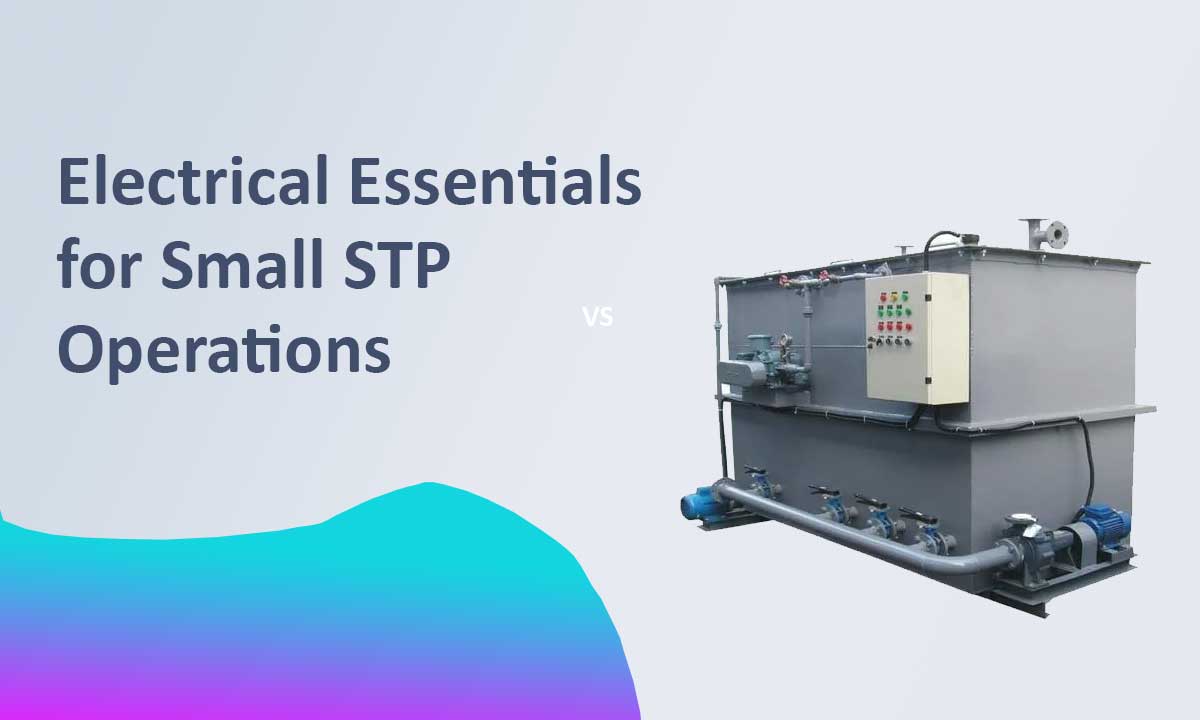Electrical Components Required for a Small STP Plant: A Complete Guide
Sewage Treatment Plants (STPs) play a vital role in managing wastewater generated from residential complexes, offices, and small commercial units. While the core of sewage treatment relies on biological and mechanical processes, electrical components are fundamental for ensuring continuous, efficient, and safe operation. From powering pumps to automating control systems, the electrical setup forms the backbone of any functional STP.
In this comprehensive guide, we’ll delve into the various electrical components required for a small STP plant. We’ll also explore power requirements, safety protocols, backup systems, and energy efficiency strategies to ensure reliable plant performance.
Why Electrical Systems Matter in STPs
Electrical systems are crucial for running every part of a sewage treatment plant. Without electricity, key processes such as aeration, pumping, sludge dewatering, and monitoring would come to a halt. An efficient electrical layout not only supports smooth operation but also improves energy management, reduces breakdowns, and increases the plant’s lifespan.
Core Electrical Components in a Small STP
1. Pumps
Pumps are essential for moving sewage through various treatment stages. Depending on plant size and design, different pumps (submersible, centrifugal, dosing) are used for:
- Lifting raw sewage
- Recirculating sludge
- Discharging treated water
Power Needs:
- Single-phase or three-phase depending on the load
- Proper motor selection based on head and flow rate
2. Blowers and Aerators
Aeration is critical for biological treatment. Blowers supply oxygen to aerobic microorganisms that break down organic matter. Surface aerators or diffused aeration systems may be used.
Electrical Requirements:
- High-power motors
- Continuous operation for optimal bacterial activity
3. Control Panels and Automation Systems
Modern STPs rely on intelligent control panels to manage plant functions and optimize performance. These include:
- Programmable Logic Controllers (PLC)
- Human Machine Interfaces (HMI)
- Real-time monitoring sensors (DO, pH, ORP)
Functions:
- Automating valve and pump operation
- Monitoring water quality
- Ensuring alarms for system failures
4. Lighting and Auxiliary Loads
Proper lighting in control rooms, equipment areas, and pathways ensures operational safety. Auxiliary loads also include:
- Alarm systems
- Security cameras
- Ventilation fans
Power Supply Requirements for a Small STP
Voltage and Frequency
- Typical requirements are 230V (single-phase) or 415V (three-phase)
- Frequency: 50 Hz or 60 Hz depending on region
Load Calculation
- Total connected load should be calculated to size transformers, switchgear, and generators
- Include starting current for motors
Single-phase vs. Three-phase
- Single-phase suitable for very small STPs (<10 KLD)
- Three-phase required for 10 KLD and above, or where blowers/pumps are heavy-duty
Electrical Safety Measures in STPs
STPs operate in a moist and corrosive environment, making electrical safety a top priority. The following components ensure electrical safety and reliability:
1. Waterproof and Corrosion-resistant Panels
- Use IP65 or higher-rated enclosures
- Stainless steel or powder-coated panels for corrosion resistance
2. Proper Earthing and Grounding
- Essential to prevent electrical shock hazards
- Protects both equipment and personnel
3. MCBs, RCCBs, and Fuses
- Protect circuits against overload, short circuits, and leakage
4. Explosion-proof Fixtures (where applicable)
- Especially important in anaerobic zones where methane gas may be present
Backup Power Solutions
STPs require uninterrupted power to avoid treatment failures and regulatory non-compliance. Backup power systems include:
Diesel Generators
- Used as the main backup during long outages
- Sized based on total plant load with a buffer
UPS Systems
- Keeps PLCs, sensors, and essential control systems running temporarily
- Ensures smooth shutdown/startup during outages
Solar Power Integration
- Helps reduce dependency on the grid
- Ideal for STPs in remote areas or with sustainability goals
Enhancing Energy Efficiency
STPs are power-intensive; hence energy efficiency can drastically reduce operational costs. Here’s how to improve efficiency:
1. Energy-efficient Motors
- Use IE2 or IE3 efficiency-rated motors
- Reduce heat loss and lower power bills
2. Variable Frequency Drives (VFDs)
- Installed on pumps and blowers
- Adjust motor speed based on real-time demand
3. LED Lighting
- Replace conventional lighting with energy-saving LEDs
4. Load Optimization
- Run pumps and blowers during off-peak hours where possible
- Regularly maintain motors and replace faulty parts
Installation and Maintenance Best Practices
Qualified Electrical Installation
- Engage licensed electricians familiar with STP layouts
- Adhere to local electrical codes and BIS standards
Routine Maintenance
- Inspect wiring, connections, and panels regularly
- Test earthing, alarms, and UPS functions periodically
Safety Compliance
- Ensure staff wear PPE and follow lock-out tag-out (LOTO) protocols
- Display electrical hazard signage
Summary: Electrical Essentials for a Reliable STP
Understanding the electrical requirements for a small STP plant is essential for its safe and efficient operation. Here’s a quick recap:
- Key Equipment: Pumps, blowers, control panels, sensors
- Power Supply: Typically 230V/415V, 50 Hz, with proper load balancing
- Safety Measures: Waterproof panels, grounding, MCBs, explosion-proof designs
- Backup Systems: Diesel generators, UPS, solar integration
- Efficiency Tactics: VFDs, high-efficiency motors, LED lighting
Whether you’re setting up a new STP or optimizing an existing one, investing in a well-planned electrical system ensures compliance, reliability, and long-term cost savings.
Need Help Designing Your STP’s Electrical System?
At 3D Aqua, we specialize in designing efficient and reliable sewage treatment systems tailored to your needs. Our experts can help you plan the ideal electrical configuration to meet capacity, safety, and sustainability goals.
Call us at +91-6262629090 or email info@3daqua.in for assistance.
Ensure your STP runs without a hitch—power it the right way!

